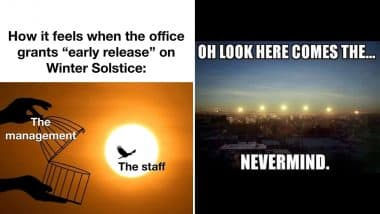As the northern hemisphere marks the beginning of summer with summer solstice, it is the winter solstice for those in Southern hemisphere. Search engine Google has made a special doodle to kick off the winter vibes. The doodle features a penguin chilling in a parachute with snowflakes falling around. On this day, the sun is at its farthest point from the southern hemisphere, hence it will be the longest night here as opposed to the longest day for those in the northern hemisphere. Google also made a search engine to celebrate the beginning of summer a day ago. In today's doodle for the winter solstice, the design is similar but the setting changes from summer to winter. The flamingo gets replaced with a penguin in a hot air balloon.
Know More About Winter Solstice
Winter solstice is also called as midwinter. A solstice is when the Earth poles tilt away from the Sun. It occurs twice a year, summer and winter solstice for each hemisphere respectively. So when summer kicks off in the north, it is the beginning of winter in the South. As the Northern hemisphere marks the Summer solstice today, it is the winter solstice in the south. So it will be the shortest period of daylight and the longest night of the year. Summer Solstice 2020 Wishes and Images: It’s the First Day of Summer, Netizens Flood Twitter Timeline With Gorgeous Sunrise Views & Other Pics to Celebrate the Longest Day of the Year.
Winter solstice is also called as June solstice, hibernal solstice and midwinter. For those in the northern hemisphere, it occurs between 20-22 December. Winter solstice is also a significant time in many cultures which is celebrated with festivals. Winter solstice marks the reversing of the long nights and shortened days. In some cultures, the winter solstice was a celebration of the moon energy by the Pagans.
Dr Vanessa Moss, astronomer at the CSIRO, Australia's national science agency, has explained the phenomenon of it getting colder here after winter solstice. As the southern hemisphere is tilted further from the Sun, the angle at which sunlight hits the Earth is shallower, so the light and energy spreads across a larger area. She was quoted to ABC, "So because the energy is spread out, it also means that the Sun feels weaker. It's not as intense and the heat is not as effective."
(The above story first appeared on LatestLY on Jun 21, 2020 01:12 PM IST. For more news and updates on politics, world, sports, entertainment and lifestyle, log on to our website latestly.com).












 Quickly
Quickly





















